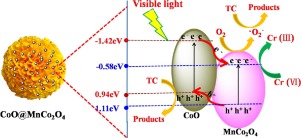Applied Catalysis B: Environment and Energy ( IF 20.2 ) Pub Date : 2018-05-21 , DOI: 10.1016/j.apcatb.2018.05.060 Jianhua Zheng , Zhang Lei

|
Most previous reported photocatalysts designs show that, either photocatalytic oxidation (PCO) or reduction (PCR) is inhibited due to the insufficient govern of the photo-excited h+ and e−. To overcome this problem, we consider that both PCO and PCR could be improved simultaneously by employing suitable photocatalyst. Herein, the novel 3D marigold flower-like hierarchical architecture [email protected]2O4 was successfully synthesized by anchoring CoO nanoparticles (NPs) on MnCo2O4 flower using a facile solvothermal method followed thermal annealing treatment under N2 atmosphere for the first time. This strategy relies on the formation of a p-n heterostructure with matching energy band gaps, in which CoO NPs tightly adhere to the surface of hierarchical MnCo2O4 microflowers, and the flower-like MnCo2O4 act as scaffold to disperse CoO NPs. The as-fabricated [email protected]2O4 hybrid not only presented remarkable performance for PCO of tetracycline (TC) but also exhibited excellent PCR of hexavalent chromium (Cr (VI)) under visible light irradiation. Meanwhile, the photocatalyst also can be used for treatment a mixture of them and exhibited promoted photocatalytic efficiency. That's the primary reason that h+ and e- can play their own roles to accomplish PCO and PCR, respectively. Moreover, the unique 3D hierarchical microflowers structure not only provide a higher specific surface area, sufficient active sites and enhanced light harvesting, but also significantly decrease the aggregation of CoO particles. The appearance photocatalytic mechanism of the p-n heterostructure system was also discussed in detail. The facile synthesis strategy and outstanding photocatalytic performance make the 3D hierarchical architecture [email protected]2O4 a promising candidate as a visible light photocatalyst.
中文翻译:

将CoO纳米粒子掺入3D万寿菊花状分层结构MnCo 2 O 4中,以高度增强太阳光的光氧化和还原能力
大多数以前报道的光催化剂的设计表明,无论是光催化氧化(PCO)或还原(PCR)被抑制由于不足支配光激发H的+和e - 。为了克服这个问题,我们认为通过使用合适的光催化剂可以同时改善PCO和PCR。在这里,新颖的3D万寿菊花状分层结构[受电子邮件保护] 2 O 4的合成成功的方法是:采用溶剂热法将CoO纳米颗粒(NPs)锚固在MnCo 2 O 4花上,然后在N 2下进行热退火处理第一次的气氛。该策略依赖于具有能带隙匹配的pn异质结构的形成,其中CoO NPs紧紧附着在分级MnCo 2 O 4微型花的表面上,而花状MnCo 2 O 4则充当分散CoO NPs的支架。制成的[受电子邮件保护的] 2 O 4杂化物不仅在四环素(TC)的PCO方面表现出卓越的性能,而且在可见光照射下还具有出色的六价铬(Cr(VI))的PCR性能。同时,光催化剂也可以用于处理它们的混合物并表现出提高的光催化效率。这就是h +和e-可以分别发挥作用来完成PCO和PCR。此外,独特的3D分层微花结构不仅提供了更高的比表面积,足够的活性位点和增强的光收集能力,而且还显着降低了CoO颗粒的聚集。还详细讨论了pn异质结构体系的外观光催化机理。简便的合成策略和出色的光催化性能使3D分层体系结构(受电子邮件保护)2 O 4成为可见光光催化剂的有前途的候选者。










































 京公网安备 11010802027423号
京公网安备 11010802027423号